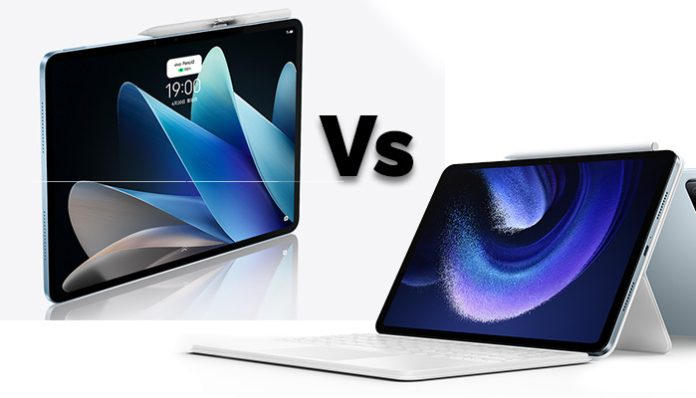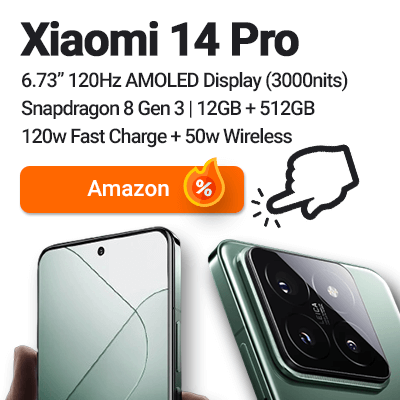
Xiaomi Pad 6 Pro Vs VIVO Pad2
2023 is an exciting year for tablet lovers as we’re finally seeing flagship-level slabs of media-goodness at reasonable prices! Samsung… you better be scared… Xiaomi and VIVO are coming for you!
In this tablet comparison, we’re going to deep dive into the closely matched Xiaomi Pad 6 Pro & the hotly anticipated VIVO Pad2!
- Related: What’s the Best Gaming Tablet?
- Related: Redmi Pad Review – Budget Wonder!
- Related: Xiaomi Pad 6 vs Xiaomi Pad 6 Pro – Which is Best Value?
Both are featuring high-end performance chips that are capable of Genshin’ing at max settings!
So let’s compare the two most exciting all-rounder tablets to be released in this year!

The Quick Answer – Which is Better & Why?
If you’re looking for a quick overview of the main differences between these two tablets, I’m not gonna waste your time!
Why Choose The VIVO Pad2?
- You’re looking for a larger 12.1″ tablet
- You want great Productivity & Gaming Performance
Why Choose The Xiaomi Pad 6 Pro?
- You Prefer a smaller & Lighter 11″ Tablet
- Quicker 67w Fast Charging (50% Faster than the VIVO Pad2)
- You’re big into unwieldy tablet photography???
- You want to emulate games (Snapdragon works best)
It’s a really difficult comparison this time around. Almost all of the great features inside the Xiaomi Pad 6 Pro are also available on the VIVO Pad2.
But there are a few key differences that’ll sway you!
Let’s dive in!

Price & Availability
In terms of pricing, it’s identical between the two units with them both selling in China for 2499 yuan. Once the global variants are released, it’ll be interesting to see how the two stack up against each other.
- Xiaomi Pad 6 Pro Price: £299.99 (2499 Yuan)
- VIVO Pad2 Price: £299.99 (2499 Yuan)
You can expect this price to increase around 20-25% once they’re released officially into secondary international markets. Still, it’s a long way off from the fruity competitors pricing! cough-cough Apple.
In terms of availability, Xiaomi has a much better track record of releasing it’s products to global markets in global variants which bags it the win! Only just.
Winner: Xiaomi Pad 6 Pro

Display
Xiaomi Pad 6 Pro
- 11-inch IPS Display
- 144Hz Variable Refresh Rate
- Corning Gorilla Glass 3
- 16:10 Screen Ratio
- 2.8K (2800 x 1800 resolution)
- 550nit Peak Brightness
- HDR10, P3 wide colour gamut
- Eye Comfort Protections (TÜV Rheinland, Blue Light, Anti Flickering, Colour Tones)
VIVO Pad2
- 12.1-inch IPS Display
- 144Hz Variable Refresh Rate
- 7:5 Screen Ratio (Squarer Design)
- 2.8K (2800 x 1968 resolution)
- 600nit Peak Brightness
- HDR10, P3 wide colour gamut
- Eye Comfort Protections (Blue Light, Anti Flickering, Colour Tones)
It’s a close one between these two tablets. While the VIVO Pad2 sneaks away with a little extra brightness… the Xiaomi Pad 6 Pro has Gorilla Glass protection.
In terms of black levels, contrast and punchy colours. There’s little to distinguish between the two tablets. Both companies are experts in choosing high-end displays for their products.
Winner: Draw
Design
Xiaomi Pad 6 Pro
- Aluminium Unibody Design
- 490 grams
- 6.51mm thickness
- Rounded Display Corners
- Colours: Black, Mountain Blue & Gold
VIVO Pad2
- Aluminium Unibody Design
- 585 grams
- 6.95mm thickness
- Rounded Display Corners
- 6.9mm Slim Bezels
- Colours: Grey, Blue & Purple
Again, it’s a draw. Both tablets have taken their fruity inspiration and made tablet clones of the most popular tablet of all time.
The only design factor to consider when choosing between them is if you prefer a circle or square camera bump and picking you’re favourite colour.
Winner: Draw
Performance, Benchmarks & Gaming
Okay, this is where things will get a little more exciting… or so I thought… We’re pitting the two giants of mobile chips against each other! MediaTek Vs Qualcomm and the results are good news for consumers but a little boring.
Xiaomi Pad 6 Pro
- Graphics: Adreno 730
- RAM: 8GB or 12GB LPDDR5
- Storage: 128GB or 256GB or 512GB UFS 3.1
- AnTuTu Performance Score: 1006603
- CPU 257778
- GPU 400071
- Memory 156049
- UX 188263
- Geekbench 5:
- Single-core: 1284
- Multi-core: 3846
VIVO Pad2
- CPU: MediaTek Dimensity 9000 (4nm)
- Graphics: Mali-G710 GPU
- RAM: 8GB or 12GB LPDDR5
- Storage: 128GB or 256GB or 512GB UFS 3.1
- AnTuTu 9 Performance Score: 967557
- CPU: 220397
- GPU: 422572
- Memory: 157833
- UX: 164547
- Geekbench 5:
- Single-core: 1283
- Multi-core: 4314
The Snapdragon Adreno GPU sneaks ahead in raw gaming fps performance by around 5%. There is also better driver support for playing older games on the Snapdragon chipsets compared to MediaTek’s Dimensity.
In terms of raw productivity performance, single-threaded applications will perform equally well between the two chips. When multitasking, the Dimensity 9000 sneak ahead with a 10% higher score.
In reality, when using these two tablets for gaming or productivity, there’s little difference.
Winner: Draw
Battery Life & Charging
The two tablet makers have chosen different approaches to battery life.
The Xiaomi Pad 6 Pro opts for an 8600mAh battery paired up with ultra-fast 67watt charging.
Related: Best Phones for Battery Life
The VIVO Pad2 used a larger 10000mAh battery but with slower 44watt charging. Let’s remember though, this larger battery has to power that extra inch of display.
Since tablets are mobile and handheld, the Pad 6 Pro’s lighter design wins it for me. And being able to charge the battery 50% faster on the Xiaomi Pad 6 Pro is another great plus.
With that said, both tablets are very capable and blow the competition out of the water when it comes to battery life vs weight vs charge speeds. The Xiaomi Pad just has the edge.
Winner: Xiaomi Pad 6 Pro
Connectivity
Xiaomi Pad 6 Pro
- WiFi 6
- USB Type-C 3.2 Gen1
- Bluetooth 5.3
- NFC
VIVO Pad2
- WiFi 6
- USB Type-C 3.2 Gen1
- Bluetooth 5.3
- NFC
Both tablets have great connectivity options and both are using the the latest standards. It’s a draw.
Winner: Draw
Pen / Stylus Support
Okay, for you creatives out there, let’s compare the Pen Support between the two tablets.
Neither of the base models of each tablet includes the Stylus in the box, but come as an extra upgrade bundle at the time of purchase or as a separate purchase.
In terms of design, both pens opt for a sleek white finish with a groove down one side for extra grip. The Xiaomi Stylus uses 2x physical buttons compared to VIVO with a capacitive area which supports taps and slide inputs.
Xiaomi Pad 6 Pro
- Name: Mi Stylus Gen 2
- Price: 59USD (449Yuan)
- Charging: Wireless Magnetic (Lithium)
- Pressure Sensitivity: 4096 Levels
- Nib: 1x Soft Nib Included
- Buttons: Physical x2 (Short & Long Press) Customisable.
- Extras: 7 Hours Battery from 1 minute charging (150 Hours @ 100%)
- Compatible: Mi Pad 5, Xiaomi Pad 6, Pad 6 Pro,
VIVO Pad2
- Name: VIVO Pencil2 Stylus
- Price: 69USD (499Yuan)
- Charging: Wireless Magnetic (Lithium)
- Length: 16.5cm
- Thickness: 8.9mm
- Weight: 16g
- Pressure Sensitivity: 4096 Levels
- Nib: 1x Soft & 1x Hard Nib Included
- Buttons: Capacitive Double Tap Stem, Slide Stem
- Extras: Presentation Pointer, Linear Vibration Motor
- Compatible: VIVO Pad2, iQOO Pad.
While the VIVO Pencil2 is a capable pen with support for tilt and pressure sensitivity. The Xiaomi Stylus Gen takes the win thanks to its fantastic battery life and customisable buttons via the OS while coming in $10 cheaper.
Winner: Xiaomi Stylus Gen 2
Extras
Modern tablets in 2023 are more than just the Candy-Crush popping big-screens of the past. Let’s discuss some of the extra features that the Xiaomi Pad 6 Pro & VIVO Pad2 offer.
Desktop Productivity Mode
Both tablets have their own dedicated desktop modes that work by connecting the tablets via video-over-type to a larger display or TV. Similar to Samsung’s Dex Mode, MIUI Desktop and VIVO PC let you open and resize windows with full Bluetooth mouse and keyboard support.
Xiaomi Pad 6 Pro
- Desktop Mode: MiUI Desktop
- Mouse & Keyboard Support: Yes
- Windowed Mode: Yes
- Mirror Mode: Yes
VIVO Pad2
- Desktop Mode: VIVO PC
- Mouse & Keyboard Support: Yes
- Windowed Mode: Yes
- Mirror Mode: Yes
In terms of features, the two seem similar but in reality, Xiaomi’s desktop mode gets the win. Why? It’s a much more streamlined experience with a small learning curve compared to VIVO’s desktop mode.
Winner: Xiaomi Pad 6 Pro
The Verdict (Xiaomi Pad 6 Pro Vs VIVO Pad2) – Which is best?
With the Xiaomi Pad 6 Pro & the VIVO Pad2 offering the same sleek metal design and vivid & bright high-resolution displays as Samsung but at half the price-point. It’s a breath of fresh air in the tablet market.
If you still want the best OLED display, you’ll have to opt for an iPad or the Galaxy Tab, but most of us only notice the difference in a side-by-side comparison making these two, the Best-bang-For-Your-Buck high-end tablets in 2023!
Between these two tablets, the winner has to be the Xiaomi Pad 6 Pro!
Why?
Charging tablets is one of the most irritating aspects of owning one. Having double the charging speed of the VIVO Pad2 sneaks it the win! The MIUI software is a little more refined and offers some additional features compared to VIVO’s Origin OS3.
The Winner? Xiaomi Pad 6 Pro
If you want that extra screen real estate of the VIVO Pad2 though? You won’t be disappointed.
Don’t forget to check out our other Tablet Guides so that you can make the best-informed decision for your needs!
Xiaomi Pad 6 Pro Vs VIVO Pad2 – Full Specs Comparison
| Specification | Xiaomi Pad 6 Pro | VIVO Pad2 |
|---|---|---|
| Size | 253.95mm x 165.18mm x 6.51mm | 266.03mm x 191.60mm x 6.59mm |
| Weight | 490g | 585g |
| Colours | Black, Gold, Far Mountain Blue | Distant Mountain Gray, Qinghai Blue, Nebula Purple |
| Processor | Snapdragon 8+ Gen 1 Flagship, TSMC 4nm, Octa-core up to 3.2GHz | Dimensity 9000, 4nm, 8-core (1 x Cortex-X2 + 3 x Cortex-A710 + 4 x Cortex-A510) |
| GPU | Adreno 730 GPU (0.8MHz Boost), Qualcomm AI Engine | APU 590 – 848MHz GPU frequency |
| Display | 11-inch 2.8K LCD, 2880×1800, 309 PPI, 144Hz refresh rate, 240Hz stylus sampling | 12.1-inch 2.8K LCD, 2800×1968, 284 PPI, 144Hz refresh rate, 120Hz/144Hz/180Hz touch sampling |
| Memory & Storage | 8GB/12GB LPDDR5 RAM, 128GB/256GB/512GB UFS 3.1 Storage | 8GB/12GB LPDDR5 RAM, 128GB/256GB/512GB UFS3.1 Storagce |
| Battery & Charging | 8600mAh, 67W fast charging, USB Type-C | 10000mAh, 44W flash charging, USB Type-C |
| OS | MIUI Pad 14, Android 13 | OriginOS 3 tablet customization system, Android 13 |
| Cameras | 50MP main rear, Depth of field lens, 20MP front, 4K video up to 60fps | 13MP main, 2MP macro rear, 8MP front, 4K rear video, 1080p front video |
| Audio | Dolby Atmos, 4 speakers, 4 microphones, Hi-Res Audio | Quad Speakers Array (Liuyang Super Audio System) |
| Connectivity | USB 3.2 Gen1, WiFi 6, Bluetooth 5.3, NFC | USB 3.2 Gen1, WiFi 6, Bluetooth 5.3, NFC, DP high-definition projection (4K 60Hz MAX), OTG reverse charging |
| Sensors | Acceleration, Gyroscope, Front & Rear Ambient Light, Hall, Side Fingerprint | Gravity, Light, Electronic Compass, Gyro, Hall Sensor |
| Pen & Keyboard | Keyboard magnetic suction contact connection, pen magnetic suction | Touch keyboard Pogo Pin connection, stylus wireless charging magnetic strip |











